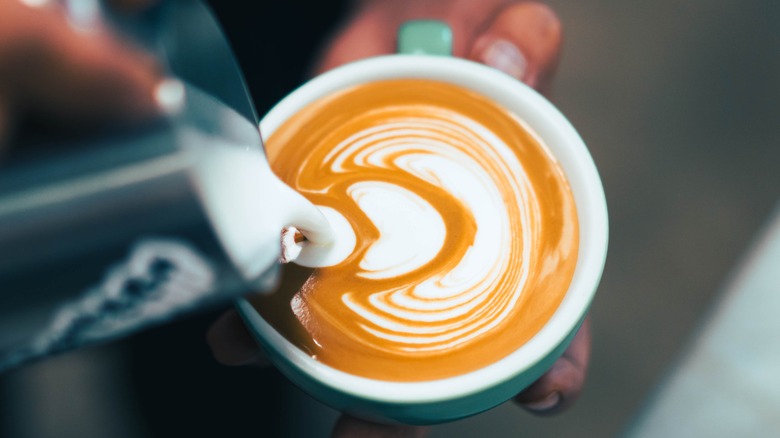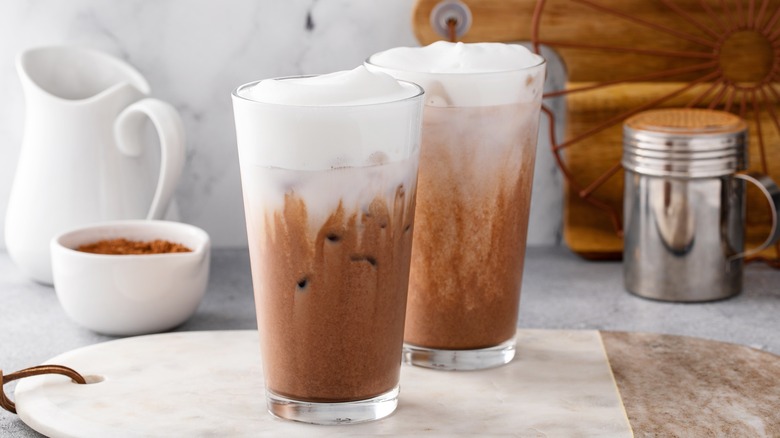The Difference Between Cold And Hot Foams In Your Coffee
Sipping coffee through a creamy foam layer is one of life's simple pleasures. The tiny bubbles of air in the milky layer atop your coffee create a delicious mouthfeel and visual appeal we just keep coming back for. Whether you prefer hot or cold coffee, you can enjoy this luxurious experience thanks to the versatility of the proteins in dairy milk and even some non-dairy choices.
Both hot and cold foams are made of trapped air bubbles that increase the milk volume, making that smooth texture. Hot air expands, making warm foam easy to create in many different milks and even creams. Because of that versatility, hot foam can be created with a range of bubble sizes, from microfoam to large airy froth depending on the milk used. Cold foam relies on air being forced into the milk without the advantage of heat. Milk can be whipped up or shaken to create foam but the weight of milk fat will collapse the bubbles, so it's best created with non-fat milks.
Hot foam on warm drinks
Hot foam is easiest to make with the steamer wand of an espresso machine or a special frothing pitcher. The steam in the wand warms the milk and the pressure of the air forced through it creates the bubbles. Frothing pitchers contain a whisk and heating element; they are not quite as powerful as a steam wand, but they are less expensive and take up less space than an espresso machine. Careful attention to frothing milk results in several textures of hot foam in the pitcher, from a light cloud that will stand up on a cappuccino to the thick, creamy microfoam that will float on hot coffee to create a beautiful latte art surface.
Whole dairy milk creates the most luxurious foam because it's just the right combination of fat, milk sugar, and protein. Steaming milk with less fat content results in bigger bubbles that last longer without deflating and float effortlessly on the top of your coffee. Non-dairy milks like oat and soy make better foam than lower-fat almond milk does, but you may want to reach for the barista blend versions of plant-based milks. They've been formulated to make a more satisfying foamy result. Coffee bars usually don't flavor milk before they create foam because flavored syrup can gum up the steam wand, so the warm foam is jazzed up with a sprinkle of spice on top if you want extra flavor.
Cold foam for iced drinks
To experience the pillowy texture of foam without warming up a cold coffee drink, we turn to cold foam. This light and airy topping is simply created by forcing air into milk. The milk can be whizzed up with a handheld frother or pitcher while still cold to produce foam, but in this case, non-fat milk works best. Milk fat is heavy and will weigh down a cold foam quickly, causing it to dissolve before you've reached the end of your drink. Cold foam is a little stiffer than warm foam because it lacks that fat.
You can add flavored syrup to the milk before you foam it, or get more creative and whip up your own pumpkin spice cold foam for your favorite iced coffee. Some coffee retailers use barista blend milks for cold foam because of their thickeners, but we've got a simple tip for you to sweeten and thicken up your cold foam — stir a spoonful of powdered sugar into the non-fat milk before you froth it. Powdered sugar dissolves quickly and contains a bit of cornstarch that will make your cold foam smooth and long-lasting.


